TAKE only memories, leave nothing but footprints.
What might have once been a magnet on a fridge or meme on a phone is now translating into positive action by tourists becoming more aware of the impact of their holidays.
With eco-responsibility on the rise and climate change in the spotlight throughout 2019, industry experts are predicting 2020 will be the year of conscious travel.
As attitudes and expectations change, mindful tourism is expected to become more of a consideration when deciding what to do with those precious days of annual leave.
US media company Forbes is predicting a rise in eco-aware hotels – with zero plastic, giving back and using local produce predicted to be at the top of travellers’ wish lists for the coming 12 months.
ABTA, the association for travel agents and tour operators, is also forecasting that 2020 will see sustainability issues going mainstream.
The growth of slow travel, where less on the itinerary is more, coupled with stepping away from the usual tourist hotspots to consider the environment means we are becoming more aware than ever of the impact of our holidays.
The aviation industry has also come under pressure to improve its carbon footprint while the Swedish concept of flygskam - or ‘flight shame’ - is gathering support across Europe, with travellers trying to figure out how to balance a desire to see and experience the world with the question of whether it can be done ethically at all.
Airlines are starting to pay their way, with more efficient planes, greener fuel and better carbon emission monitoring technologies, while tourists can now offset CO2 levels with a financial donation.
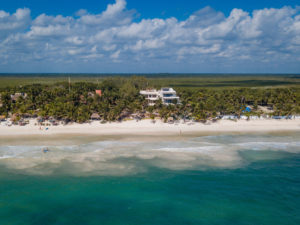 Tulum in Mexico prides itself on being eco-aware
Tulum in Mexico prides itself on being eco-awareTulum, in the Mexican state of Quintana Roo, is no stranger to the sustainability debate.
First becoming popular with tourists in the 1960s, the small fishing village has experienced a rapid rate of change and development from little-known hippie retreat to fashionable bohemian playground.
It’s also known for its emphasis on health and well-being – from yoga and meditation to traditional cleansing and purification ceremonies.
This pocket of Caribbean paradise has had its share of bad press in recent years, with reports of over-tourism, an eco-system under siege and mounds of sargassum seaweed washing up on its white sandy shorelines.
Thankfully you won’t find any high-rise hotel resorts on this strip of beach, though the need to preserve and protect its unique environment and wildlife is being recognised.
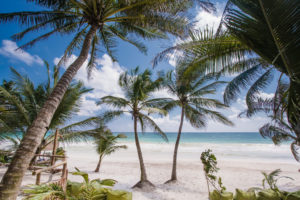 A tropical paradise awaits in Tulum
A tropical paradise awaits in TulumTulum is home to historical cenotes (natural swimming holes) , Mayan temples and pyramids, lush national parks and rainforest, and now some of its hoteliers are offering a more holistic approach to hospitality in the hope of making a positive impact.
My first visit to Tulum was in 2016 at high season (January).
Returning just three and a half years later in July, the continued development of this mostly off-the-grid area was clear with once bare spots of exotic forest now occupied with new bars, restaurants and hotels.
Among them is Zorba Beach Homes, a small collection of high-end villas opened a year ago by Snow Colbeck and Guy Kouris.
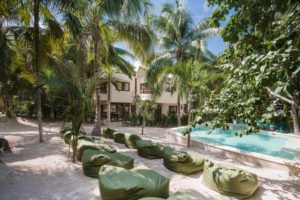 High-end villas offer comfort and luxury
High-end villas offer comfort and luxuryThe pair, who also developed and operate sister resort Mahayana Tulum, have placed an emphasis on conservation with their latest offering.
Zorba is surrounded by beach and jungle. The existing flora has been intertwined around the property with trees relocated rather than destroyed where necessary.
Water and energy conservation have also been considered throughout.
“The homes have a strong connection to the place and to the conservation of the area,” says Colbeck. “We also try to minimise our consumption of electricity and restrict the use of AC.
“We minimise laundry, supply organic local biodegradable toiletries in refillable containers and have created a decor that breathes new life into reclaimed objects.
“All the doors are recycled and many natural and renewable materials are used - bamboo, wicker and palapa. “We have onsite septic where we process our own organic waste and reuse the water from our system to water our greenery and plants,” she adds.
Recycled wood is found across the resort, blending seamlessly into the surrounds yet simultaneously making an impressive statement.
 The turtles are among the most popular locals
The turtles are among the most popular localsA long reclaimed wooden table sits by the beachfront – perfect for dinner overlooking the ocean, a spot of star gazing or simply as a platform to watch turtles quietly nesting on the beach under the moonlight.
Our arrival timed in perfectly with one of these majestic sea creatures coming ashore to lay her eggs.
Zorba doesn’t light its beach at night so that natural conditions are maintained, with nesting season running from around May to November.
The Yucatán Peninsula is home to both green and loggerhead turtles who return to the place of their birth to dig and lay their eggs – on average each female produces around 100 with just one per cent of those hatching successfully.
Like many of the hotels along the beach, Zorba creates small turtle sanctuaries by installing subtle cordons around each nest until the babies hatch and make their way to the ocean.
 You can swim with wild turtles in this piece of paradise in Mexico
You can swim with wild turtles in this piece of paradise in MexicoYou can also share the water and swim with wild turtles in nearby Akumal with Boutique Tours Tulum (boutiquetoursmexico.com) offering a range of outings.
Each of Zorba’s villas incorporate locally made furniture and light fixtures. Doors have been upcycled from nearby Merida - with its rich colonial and Mayan heritage it’s worth visiting if you can - while handcrafted tiles have also been sourced in this laid-back city.
With an earthy palette, walls and ceilings feature recycled glass bottles that help to disperse natural light around each room.
“The vibe is mellow and easy-going and many people remark how the feeling at our homes resonates with the quiet tranquil and relaxed vibe of Tulum,” Colbeck says.
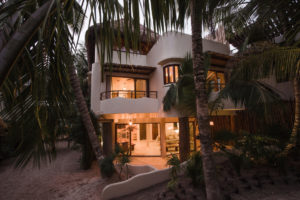 The homes exude the relaxed vibe of Tulum
The homes exude the relaxed vibe of Tulum“We were inspired to create this second collection of homes as we enjoy the lower density of homes and the greater opportunity for people to connect with each other and the place.”
Each of Zorba’s six homes - the resort sleeps no more than 44 guests in total - comes with a fully-kitted out kitchen and there is also with the option of hiring a local chef for dinner.
Chef Irma offers a choice of Mexican, Mayan and Aztec flavours (from around £30 per person - minimum charges apply) using in-season ingredients and fresh produce from her local market.
Feast on Mayan fish marinated in achiote spices and cooked in banana leaf; traditional cochinita pulled pork served with charro beans or tamales with grilled vegetables and wild rice.
Served family-style there are also breakfast and lunch options including fish tacos and ceviche, quesadillas and chilaquiles (fried tortilla cooked in salsa and sprinkled with cheese).
Colbeck says making an effort to reduce plastic use and consumption was also a key part of their vision for Zorba Beach Homes.
“All food is served on our dinnerware, with no plastic cups or dishes,” she says. “And we provide fresh drinking water in the kitchen and in every bathroom there are refillable containers for guests to enjoy.
“Sheets are changed every four nights, unless by request, and towels are changed every two days.”
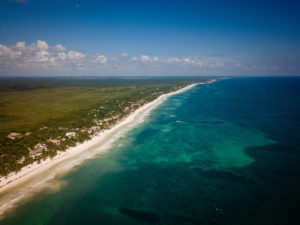 The resort is based on a huge private beach
The resort is based on a huge private beachLess than a two-hour drive from Cancún, Zorba is located on Tulum’s private beaches at KM9.
It’s surrounded on one side by the Caribbean Sea and tropical jungle on the other, which you can see and experience best from the 1,500 square foot communal rooftop patio on its oceanfront villa.
Powdery white sand intertwines each of the properties and creates a natural meandering path towards to the beach – perfect for those who like the feel of sand between their toes and are conscious of leaving nothing but footprints when they travel.
We stayed in Zorba Villa 4, a three bedroom property that sleeps 6-8 people. Rates start at around £680 per night + tax. Find further information here.
What to do
Experience Tulum’s historical and cultural offerings by visiting its local public art installations, cenotes, lagoons and ruins. Explore the jungle my foot, bicycle or rickshaw at Coba Archaeological Site - home to Nohoch Mul, the tallest Maya pyramid in the Yucatán Peninsula with a 42-metre climb.
Take a wildlife boat tour at Sian Ka’an, a UNESCO World Heritage site, where the lagoon meets the ocean and is home to sea eagles and jabiru storks, manatees and dolphins.
Where to eat
Due to its off-grid nature, the emphasis is on wood-fired cooking in Tulum. You’ll also find plenty of raw juice bars and vegan fare for all tastes. Here are some of our favourite spots:
Charly’s Vegan Tacos: Rich and flavourful plant-based dishes crafted from the secret recipes of Chef Charly’s grandmother.
Nest: Seaview restaurant and beach club.
Gitano: Jungle dining, check out the tacos.
Casa Jaguar: Delicious Instagram worthy dishes.
Hartwood: Seasonal menu inspired by the Yucatan markets and farms. The restaurant is also part of the DIF Program working to alleviate hunger in Mexico’s rural areas.
Wild: Flavoursome cocktails and inspiring seafood. Try the rosemary smoked shrimps with lime and basil.
Casa Malca: Pablo Escobar’s former home is now a hotel and does a delightful breakfast buffet.
How to get there
British Airways flies from London to Cancún from £568 return including taxes/fees/carrier charges. To book visit ba.com/cancun or call 0344 493 0120.
From January 2020, British Airways will offset its carbon emissions on domestic flights – it also invests in global carbon reduction projects like rainforest protection and reforestation through charity partner Pure Leapfrog.
I offset my flight to Cancún with a donation of £12 towards forest protection on Cordillera Azul in Peru.

